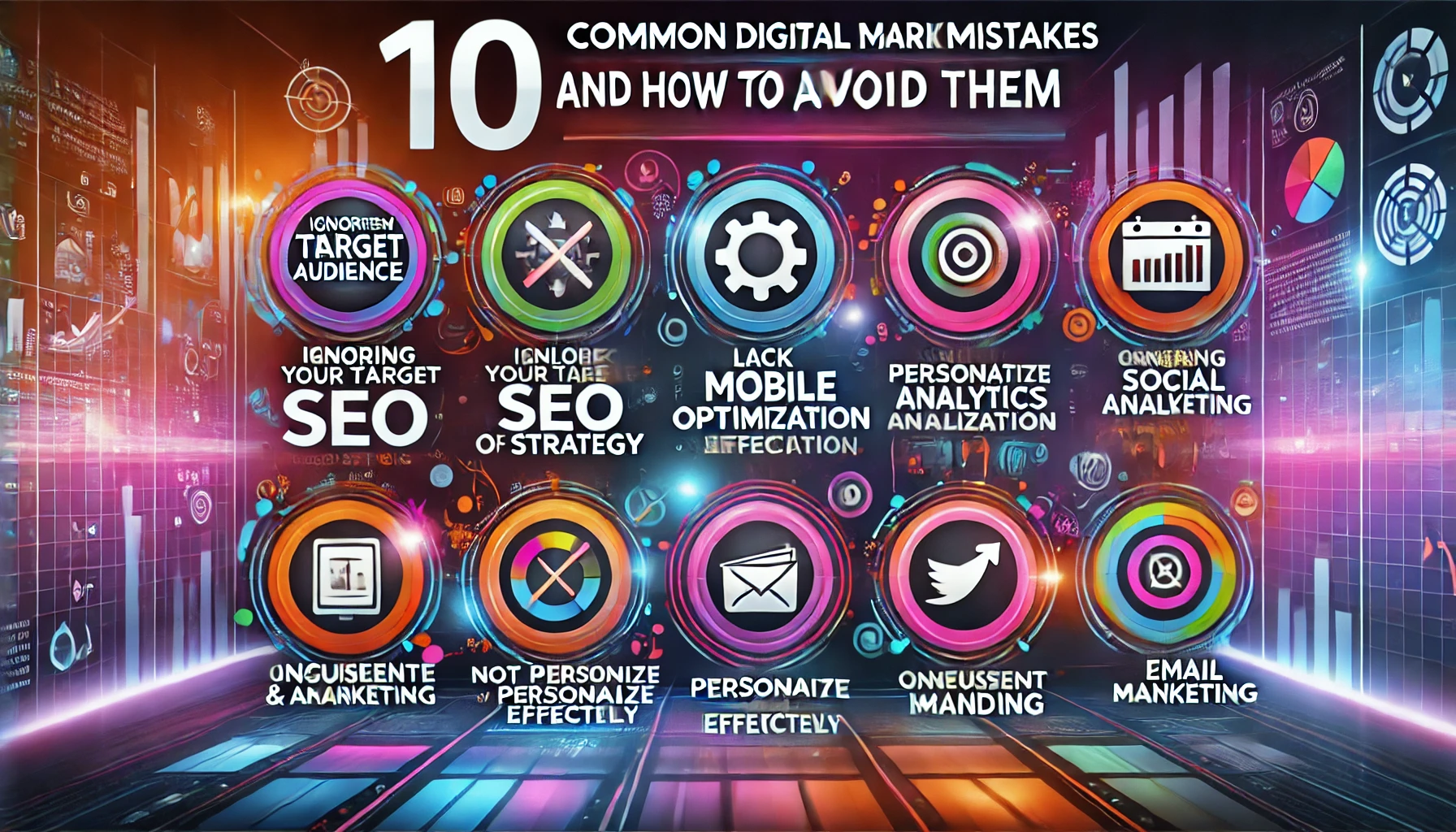10 Common Digital Marketing Mistakes and How to Avoid Them
Digital marketing is essential for reaching your audience and achieving business goals. However, many businesses make common mistakes that hinder their success. By understanding and avoiding these digital marketing mistakes, you can optimize your strategy and drive better results. In this comprehensive guide, we will explore 10 common digital marketing mistakes and how to avoid them.
1. Ignoring Your Target Audience
Ignoring your target audience is one of the biggest mistakes in digital marketing. Knowing your audience is crucial for creating relevant and engaging content.
- Identify Your Audience: Use tools like Google Analytics and social media insights to gather data about your audience’s demographics, interests, and behaviors.
- Create Buyer Personas: Develop detailed personas representing your ideal customers, including their age, gender, location, interests, and pain points.
- Tailor Your Content: Customize your content to meet the needs and preferences of your target audience.
Internal Link: For more tips on understanding your audience, check out our article on Content Marketing 101: Creating Compelling Content That Converts.
2. Lack of a Clear Strategy
Without a clear digital marketing strategy, your efforts can become disjointed and ineffective. A well-defined strategy provides direction and focus.
- Set Clear Goals: Define what you want to achieve with your digital marketing efforts, such as increasing website traffic, generating leads, or boosting sales.
- Develop a Plan: Create a detailed plan outlining the tactics and channels you will use to achieve your goals.
- Measure Success: Establish key performance indicators (KPIs) to track your progress and measure success.
3. Neglecting SEO
Neglecting SEO can result in poor search engine rankings and reduced visibility. SEO is essential for driving organic traffic to your website.
- Conduct Keyword Research: Use tools like Google Keyword Planner and SEMrush to identify relevant keywords for your industry.
- Optimize On-Page Elements: Ensure your website’s on-page elements, such as meta tags, headings, and content, are optimized for your target keywords.
- Build Quality Backlinks: Earn backlinks from reputable websites to improve your site’s authority and search engine rankings.
External Link: To learn more about SEO best practices, visit Moz’s Beginner’s Guide to SEO.
4. Overlooking Mobile Optimization
With the increasing use of mobile devices, overlooking mobile optimization can lead to a poor user experience and lost opportunities.
- Responsive Design: Ensure your website is responsive and adapts to different screen sizes and devices.
- Fast Loading Times: Optimize your website’s loading speed by compressing images, leveraging browser caching, and minimizing code.
- Mobile-Friendly Content: Create content that is easy to read and navigate on mobile devices.
5. Not Utilizing Social Media Effectively
Social media is a powerful tool for reaching and engaging your audience. Not utilizing it effectively can limit your digital marketing success.
- Choose the Right Platforms: Focus on the social media platforms that your target audience uses the most.
- Engage with Your Audience: Respond to comments, messages, and mentions to build relationships and foster loyalty.
- Consistent Posting Schedule: Maintain a consistent posting schedule to keep your audience engaged and informed.
6. Ignoring Analytics
Ignoring analytics means missing out on valuable insights that can help you optimize your digital marketing strategy.
- Use Analytics Tools: Utilize tools like Google Analytics, HubSpot, and SEMrush to track your website’s performance and gather insights.
- Monitor Key Metrics: Track metrics such as website traffic, bounce rate, conversion rate, and social media engagement.
- Adjust Your Strategy: Use the data to identify areas for improvement and make data-driven adjustments to your strategy.
7. Failing to Personalize Content
Failing to personalize content can result in lower engagement and conversion rates. Personalization enhances the relevance and impact of your marketing efforts.
- Segment Your Audience: Divide your audience into segments based on demographics, behavior, or interests.
- Personalize Emails: Use data to personalize your email content, such as addressing recipients by name and tailoring offers to their preferences.
- Dynamic Content: Implement dynamic content on your website to display personalized messages and recommendations.
8. Inconsistent Branding
Inconsistent branding can confuse your audience and weaken your brand identity. Consistent branding builds recognition and trust.
- Define Brand Guidelines: Establish brand guidelines that outline your brand’s voice, tone, colors, fonts, and imagery.
- Maintain Consistency: Ensure all your marketing materials, from your website to social media posts, adhere to your brand guidelines.
- Regular Audits: Conduct regular audits of your marketing materials to ensure brand consistency.
9. Overlooking Email Marketing
Email marketing is a highly effective channel for nurturing leads and driving conversions. Overlooking it can mean missing out on significant opportunities.
- Build Your Email List: Use lead magnets, such as ebooks or discounts, to encourage sign-ups.
- Segment Your List: Divide your email list into segments to deliver more relevant content.
- Engaging Content: Create compelling and valuable email content that encourages recipients to take action.
Internal Link: For more strategies on email marketing, read our article on Email Marketing Strategies: How to Build and Nurture Your Subscriber List.
10. Not Testing and Iterating
Not testing and iterating your digital marketing efforts can lead to missed opportunities for optimization and improvement.
- A/B Testing: Conduct A/B tests to compare different versions of your content, ads, and landing pages.
- Analyze Results: Use the results of your tests to identify what works best and what needs improvement.
- Continuous Improvement: Regularly iterate and optimize your digital marketing strategy based on data and insights.
By understanding and avoiding these common digital marketing mistakes, you can optimize your strategy and achieve better results. Focus on knowing your target audience, developing a clear strategy, prioritizing SEO, and ensuring mobile optimization. Utilize social media effectively, leverage analytics, personalize content, maintain consistent branding, and embrace email marketing. Test and iterate your efforts to continuously improve your digital marketing performance. Embrace these best practices to connect with your audience, drive engagement, and achieve your business goals.




